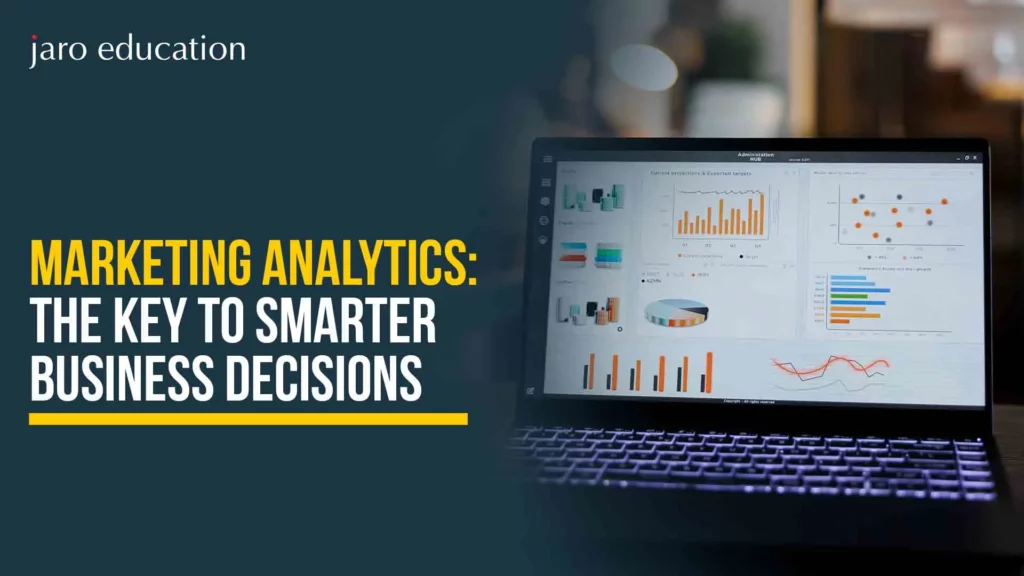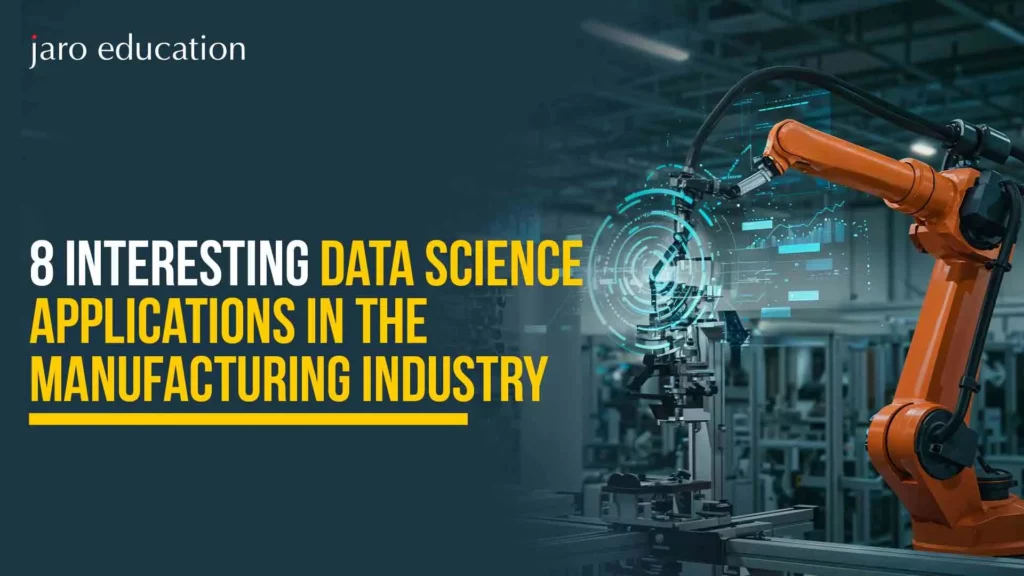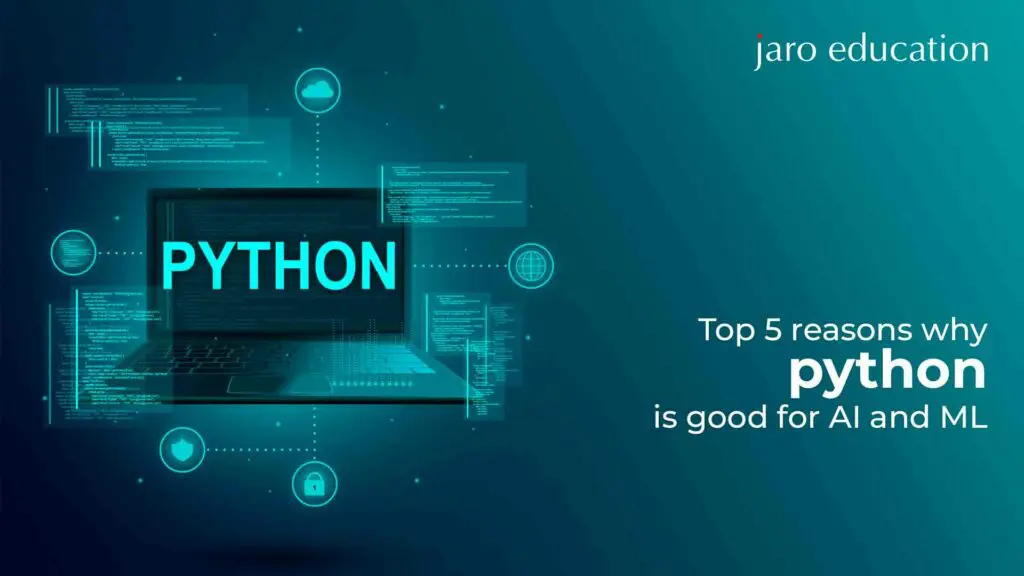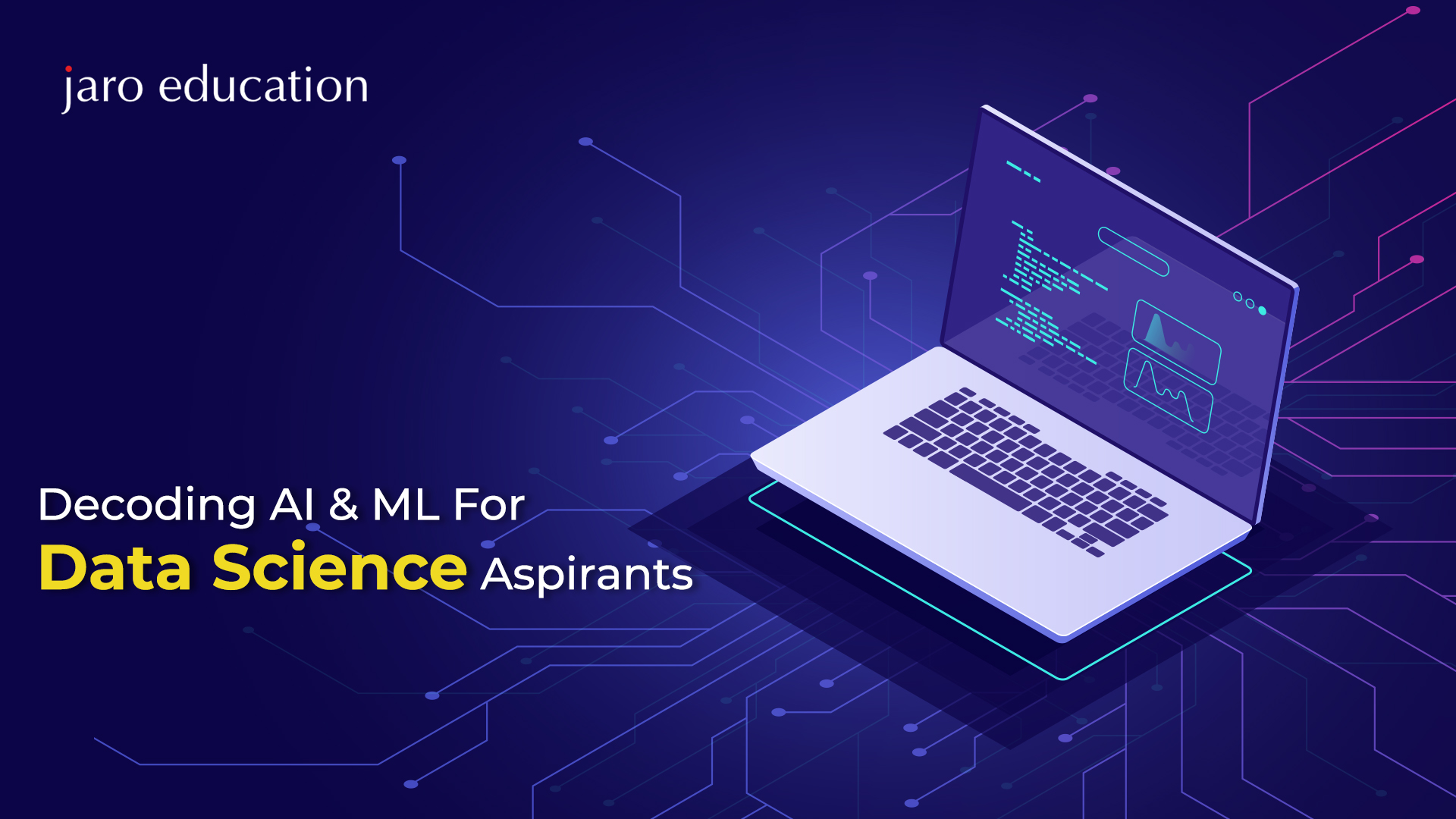Supervised vs Unsupervised Learning in Machine Learning
Table of Contents
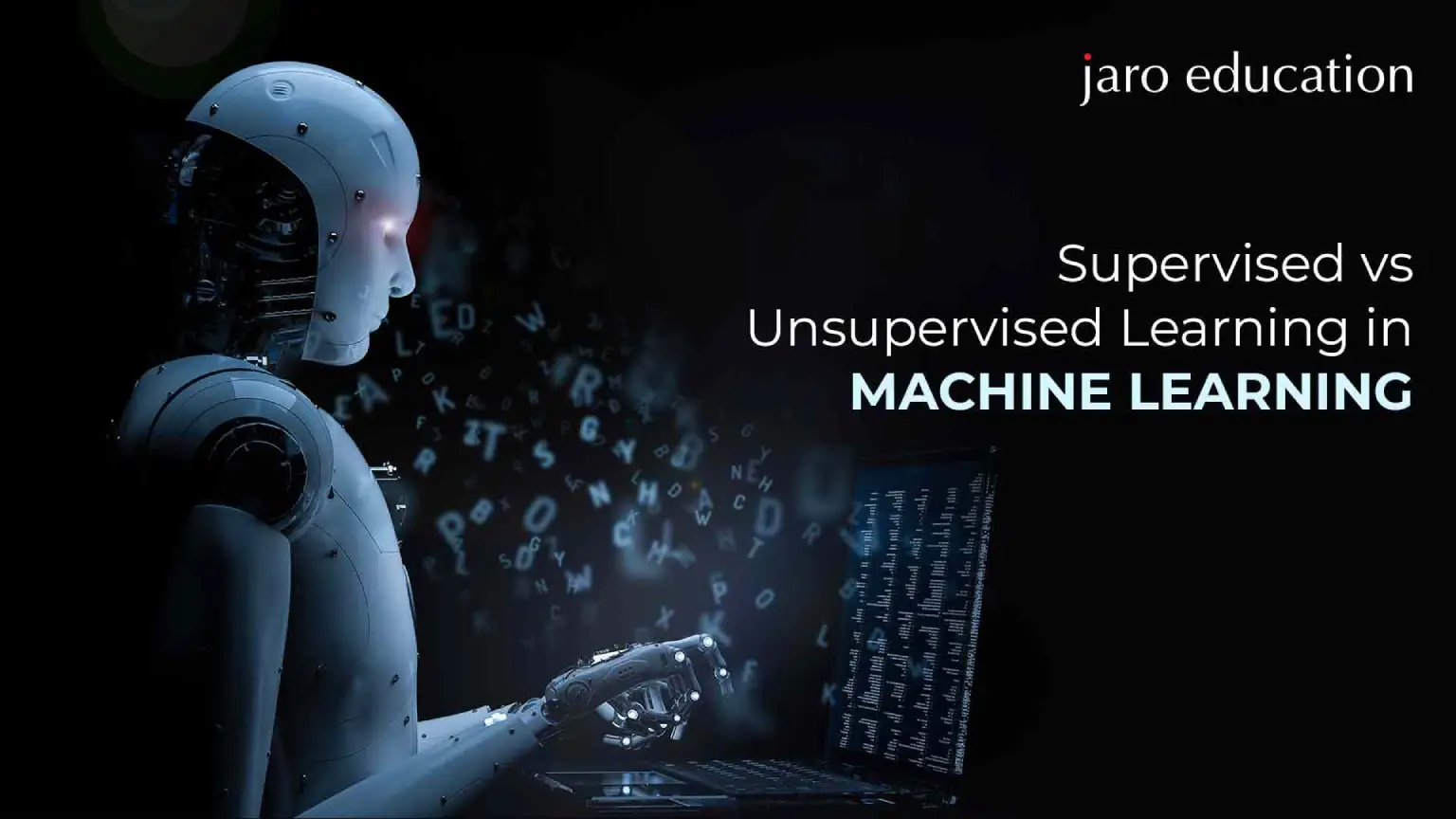
- jaro education
- 7, September 2023
- 4:00 pm
The world is transforming every day, and businesses are adopting machine learning algorithms to simplify processes and meet customer expectations. You can observe such changes in the form of face recognition for smartphone unlocking, or for identifying credit card fraud. Artificial Intelligence, refers to the development of computer systems that can perform tasks that typically require human intelligence and machine learning is a branch of artificial intelligence that enables computers to learn and make predictions from data without explicit programming. There are two main methods used for solving computational problems in machine learning and artificial intelligence that is supervised and unsupervised learning. One employs labelled data to help in result prediction, whilst the other does not. This is a major distinction. The two strategies do differ slightly from one another, and there are some crucial places where one performs better than the other. To help you pick the right course of action, this blog will explain supervised vs. unsupervised learning.
To understand supervised and unsupervised learning in a better and more detailed manner, Executive Programme in Applied Data Science with Machine Learning & Artificial Intelligence can be your ideal choice. This programme equips executives and professionals with crucial proficiencies and promotes innovative thinking and corporate growth, enabling participants to effectively utilise the potential of modern technologies within their specific industries.
Understanding Supervised Learning
As the name suggests, supervised learning involves the guidance of a supervisor who also serves as an instructor. In its simplest form, supervised learning focuses on the process of teaching or training the computer using tagged data, which indicates that the correct answer has already been assigned to certain data. For the supervised learning algorithm to examine the training data and create a proper result from labelled data, the machine is given a fresh set of examples.
Example: In supervised learning, the task is to teach a computer model to identify and categorise various fruits in a picture. To do this, provide the model with both input data (characteristics like shape, size, colour, and flavour of each fruit) and the corresponding correct output categories. After training, the model can be tested with new fruit images, and it will use its learning to recognise and classify them accurately.
Types of Supervised Learning
- Regression
- Logistic Regression
- Classification
- Naive Bayes Classifiers
- K-NN (k nearest neighbours)
- Decision Trees
- Support Vector Machine
Supervised Learning: Advantages
- Learning under supervision enables data collection and generates data output based on prior experiences.
- Uses expertise to assist, and optimise performance requirements.
- Assisted machine learning aids in the resolution of a variety of real-world computation issues.
- It carries out regression and classification tasks.
- It permits estimating the outcome or mapping it to a fresh sample.
- It can easily estimate a numerical target value from some provided labels and data.
Supervised Learning: Disadvantages
- Big data classification through supervised machine learning can be tough.
- The computing time required for training supervised learning is significant.
- All complicated machine learning tasks cannot be handled by supervised learning.
- For supervised learning, a lot of computation time is required.
- A set of labelled data is necessary.
- It calls for a training procedure.
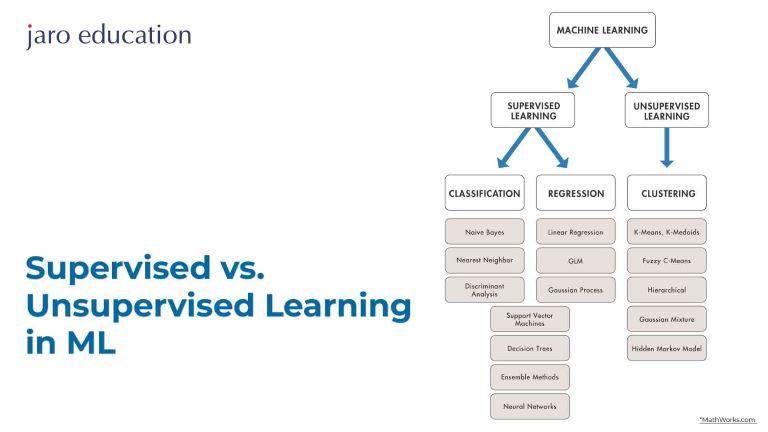
Understanding Unsupervised Learning
Unsupervised learning is the process of instructing a computer to use unlabelled, unclassified data and allowing the algorithm to act on the data without supervision. Without any prior data training, the machine’s objective, in this case, is to categorise unsorted data according to similarities, patterns, and differences. In contrast to supervised learning, no supervision is provided to the model. It solely relies on an input dataset, autonomously analysing the data to identify patterns. The model then trains itself to group fruits together based on shared characteristics that exhibit the highest similarities among them.
Types of Unsupervised Learning
Clustering, association, and dimensionality reduction are the three basic tasks that unsupervised learning models are utilised for.
Clustering
Clustering is organising objects into clusters so that objects with the highest similarities stay in one group while having little or no similarities with things in a different group. Cluster analysis discovers similarities between data objects and categorises them based on the existence or absence of such similarities.
Association
The association is a type of unsupervised learning strategy used to discover links among elements in an enormous database. It identifies the set of elements in the dataset that appear together. The association rule improves the effectiveness of a marketing approach.
Dimensionality Reduction
This unsupervised learning comes into play when a dataset holds an excessive number of features (or dimensions). It trims down data inputs to a manageable extent while upholding data integrity. Frequently used in data preprocessing, this technique eliminates visual data noise to enhance image quality, aids in managing data overload.
Unsupervised Learning: Advantages
- Unsupervised learning has no requisition of any training data to be labelled.
- It is a simple method for dimensionality reduction.
- Capable of uncovering patterns in data that were not discovered before.
- Clustering, anomaly detection, and association rule mining are just a few examples of the many problems that can be solved with unsupervised learning.
- Unsupervised learning enables data exploration and the discovery of unique, possibly helpful patterns that might not be immediately obvious.
- Because labelled data are not necessary for unsupervised learning, which can be more time- and money-consuming to gather, it is frequently less expensive than supervised learning.
Unsupervised Learning: Disadvantages
- The lack of preset answers during training makes it challenging to assess accuracy or effectiveness when using unsupervised learning.
- Results are frequently less accurate.
- In this method of learning, the user must take time to interpret and categorise the classes that fall within that classification.
- Unsupervised learning does not have access to the direction and feedback offered by labelled data, which might make it challenging to determine whether the patterns that are discovered are meaningful or useful.
- Missing values, outliers, and noisy data can all affect how unsupervised learning performs.
- Unsupervised learning has a limited ability to scale because it can be computationally expensive, especially for large datasets or complicated methods.
Distinguishing Supervised and Unsupervised Learning: Role of Labelled Data
The primary contrast between supervised and unsupervised learning hinges upon the use of labelled datasets. Supervised learning engages with labelled input and output data, whereas unsupervised learning algorithms do not rely on such labels. The elaborate distinction between supervised and unsupervised learning based on the use of labelled data is mentioned below.
Supervised Learning
In Guided Predictions through training in supervised learning, algorithms “learn” from training datasets by iteratively making predictions on data and refining them based on correct answers. While supervised models often exhibit greater accuracy compared to their unsupervised counterparts, they demand initial human intervention to appropriately label the data. For instance, a supervised model can anticipate your commute duration based on factors like time of day and weather conditions.
Unsupervised Learning
Autonomous Data Structure Discovery Unsupervised learning models, autonomously delve into uncovering the inherent structure within unlabelled data. Notably, they still necessitate some human validation for output variables. For instance, an unsupervised model can identify that online shoppers frequently buy clusters of products together. Nevertheless, a data analyst needs to confirm whether it’s logical for a recommendation system to group baby clothing with purchases of diapers, applesauce, and sippy cups.
Major Contrast Between Supervised and Unsupervised Learning
Other differences between supervised and unsupervised learning are as follows:
Goals
The goal of supervised learning is to predict outcomes for novel data with predetermined result kinds. In contrast, unsupervised learning seeks insights from extensive new data, allowing the machine learning process to discern what stands out or holds interest within the dataset.
Applications
Supervised learning finds utility in tasks such as spam detection, sentiment analysis, weather forecasting, and pricing predictions. Conversely, unsupervised learning suits anomaly detection, recommendation systems, customer personas, and medical imaging.
Complexity
Unsupervised learning necessitates tools for handling substantial volumes of unclassified data. The computational complexity of unsupervised models arises from their requirement for large training sets to yield intended outcomes. In contrast, Supervised learning represents a straightforward machine learning method, typically implemented through tools like R or Python.
Limitations
The models of supervised learning can be time-intensive to train, with the expertise required for labelling input and output variables. Conversely, unsupervised learning methods might yield markedly inaccurate results without human validation of output variables.
Supervised vs Unsupervised Learning: Selecting the Right Approach
Determining the most suitable approach depends on how your data scientists assess the nature and extent of your data alongside the intended application. To make an informed choice, consider the following steps:
Analysing Input Data
The first step involves examining your data to determine whether it has annotations or not. It’s essential to assess whether experts can contribute additional annotations, if necessary.
Setting Objectives
Next, consider the goals of your project. Are you dealing with a recurring, well-defined issue that needs to be solved? Alternatively, does the algorithm need to be prepared to tackle unforeseen challenges in the future?
Exploring Algorithm Choices
In this stage, check for the algorithm options. Check if there are algorithms that align with the desired dimensionality, which refers to the number of attributes or characteristics. Assess if these algorithms can effectively handle the scale and structure of your data.
Supervised learning grapples with classifying extensive data, yielding remarkably accurate and dependable outcomes. On the contrary, unsupervised learning excels at handling large data volumes in real-time, albeit with limited transparency into data clustering and a heightened risk of inaccuracies.
Conclusion
Gaining the data insights that make our world better with machine learning models is a potent method. Both supervised and unsupervised learning in ML are integral tools for various computing methods. They have utilities in manifolds and can make various operations of data scientists much easier. You can apply for the Executive Programme in Applied Data Science with Machine Learning & Artificial Intelligence by CEP, IIT Delhi, through Jaro Education to learn more about supervised and unsupervised learning. Through this course, you can find out more about the individual algorithms utilised with these methods and apply them in your work setup effortlessly.




